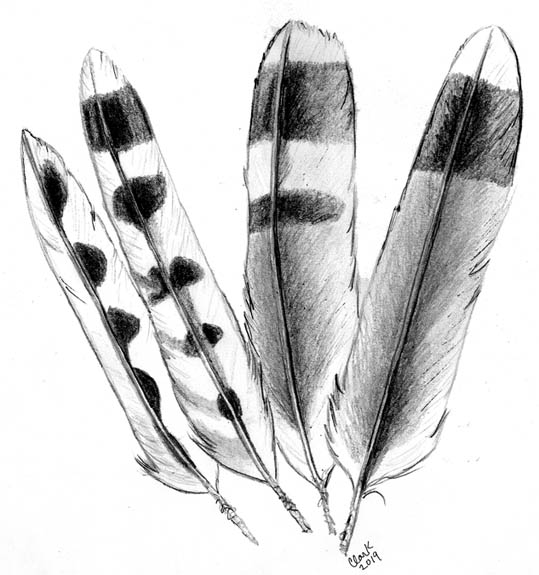
Dear Bird Folks,
Occasionally, while I’m out walking, I’ll pick up a bird feather and wonder what bird it came from. Any suggestions on how I can identify the feather without making the long drive to Cape Cod and showing it to you?
– Eric, Norton, MA
Take a picture, Eric, it’ll last longer.
Wasn’t that the old expression snobby kids would say whenever someone was accidently staring at them? Back then it was sort of a put-down. But now that everyone has a camera in his or her phone, the person being admonished can actually snap a photo of the snobby kid and post it on the internet. Technology sure has made life hard for snobby kids. Those poor dears.
What does photography have to do with feathers? The law, that’s what. For decades people have collected bird feathers and they weren’t concerned how they got them. Birds were shot, netted and trapped just for their colorful feathers. Things became so bad that the government had to step in on behalf of the birds. Today, without proper permits, it is illegal to possess the feathers of most wild birds and the law doesn’t care how you obtained them. It doesn’t make any difference if a feather is from a road-killed bird, or from a bird that is molting or if the feather floated down from the sky, Forrest Gump style. We are simply not allowed to collect feathers. What about the feathers on earrings, dream catchers, boas and other fashions? Are those illegal? No, they come from domesticated birds and thus receive no protection (much to the chagrin of the domesticated birds).
While you aren’t likely to do any serious hard time for picking up a stray feather or two, it still isn’t something I can encourage you to do. I don’t want to be labeled as an accomplice; it would spoil my spotless image. The best way to collect feathers legally is with your camera. Instead of picking up a homeless feather, take a photo. In fact, you probably should take several photos (because your finger is bound to get in the way at least once). One of the disadvantages of identifying a bird feather from a photograph is judging size. So, unless you are one of those guys who carry a tape measure around with him all the time (and believe me, they exist), you’ll need a way to gauge the feather’s length. To help with that, put your foot, or hand or even finger (on purpose this time) next to the feather while you take the picture. This will give you a good reference about the size. It’s also a nice way to create a keepsake photo of your foot. You never know when you’ll need one.
Okay, you’ve taken the photos, now what? Should you send them to me? No, don’t do that. Identifying bird feathers takes lots of training and I’m not a qualified field biologist. (My college degree is in birdseed.) However, there are two excellent sources for feather identification that you can use from home, even in Norton. One is a book entitled, Bird Feathers: A Guide to North American Species. I like this book and have used it on several occasions. Of course, not all the feathers of every bird are in the book. Showing every feather would be nearly impossible, since each bird has several thousand individual feathers. But the book does offer a selection of key feathers of nearly 400 species. The other source is the “Feather Atlas.” Have you ever heard of it? If you have, you’re better than me because I just discovered it, and it’s pretty cool.
The Feather Atlas sounds like an expensive coffee table book that you buy once and never look at again, but it’s actually a website created by the U.S. Fish and Wildlife’s Forensics Laboratory. I was surprised to learn that Fish and Wildlife has a forensics lab. Why do they even need such a thing, you ask? Good question. Are squirrels passing bad checks? Maybe they want to find out what chipmunks are really carrying in their cheek pouches. I wish the lab would help me track down what keeps stealing my suet feeder at night. (My money is on the raccoon.) While some of those things could be true, the real reason for the forensics lab is to analyze evidence gathered at crime scenes involving wildlife. This includes such awful things as parrot smuggling, poaching endangered animals and picking up feathers off the ground in Norton.
One of the by-products of the lab is the aforementioned Feather Atlas. Like the book, the atlas contains a series of photographs featuring the feathers (mostly wing and tail feathers) of hundreds of bird species. To get started, the site simply asks you to choose a pattern (two-tone, mottled, speckled, etc.) that matches your feather. Next, choose a color. That’s all. The site will give you several suggestions. You just have to find the photos that match your feather. The site also has information on feather structure and terminology. There is just one drawback: Feather length is described in something called “centimeters,” whatever they are.
Feather identification is not easy, Eric. Not only does each species have lots of feathers to choose from, but there is also the male vs. female, immature vs. adult, breeding vs. non-breeding feathers to deal with. With all that said, the Feather Atlas will at least give you a fighting chance. You should check it out online. I’d like to write more about this topic but I’m getting a call from the forensics laboratory. I think they have a lead on what keeps stealing my suet feeder. That raccoon had better lawyer-up.